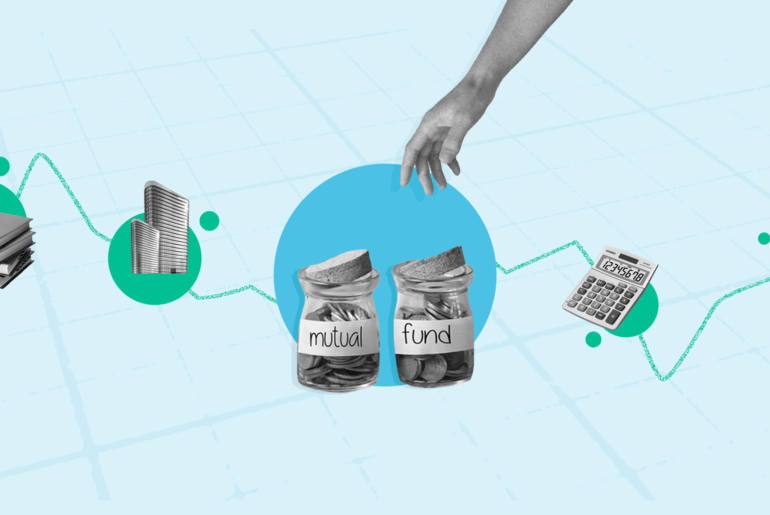Last Updated on Apr 28, 2025 by vanessa sequeira
If you’re looking to strike a balance between risk and reward, mid cap mutual funds might be the sweet spot for your portfolio. These funds focus on mid-sized companies that are often in a dynamic growth phase, offering the potential for higher returns compared to large cap funds, yet with less volatility than small caps. The appeal of mid cap funds lies in their ability to capture the growth of emerging companies that could be the market leaders of tomorrow. But with so many options available, how do you identify the best mid cap mutual funds for your investment strategy? In this article, let’s explore the best mid cap mutual funds, their features, advantages, risks, how to choose the top mid cap mutual funds, and more.
Table of Contents
Best Mid-Cap Mutual Fund
| Name | AUM (Cr) | CAGR 3Y (%) | Expense Ratio (%) | Minimum Lumpsum (Rs) | Minimum SIP (Rs) | Exit Load (%) |
| Motilal Oswal Midcap Fund | 26,028.34 | 28.09 | 0.64 | 500 | 1500 | 1 |
| HDFC Mid-Cap Opportunities Fund | 67,578.59 | 25.43 | 0.89 | 100 | 100 | 1 |
| ITI Mid Cap Fund | 987.53 | 25.15 | 0.28 | 5000 | 500 | 1 |
| Edelweiss Mid Cap Fund | 8,633.85 | 25.00 | 0.39 | 100 | 100 | 1 |
| Nippon India Growth Fund | 33,174.74 | 24.97 | 0.74 | 100 | 0 | 1 |
| Invesco India Midcap Fund | 5,779.32 | 24.79 | 0.65 | 1000 | 0 | 1 |
| Sundaram Mid Cap Fund | 11,332.71 | 23.53 | 0.9 | 100 | 1000 | 1 |
| Mahindra Manulife Mid Cap Fund | 3,397.92 | 23.21 | 0.48 | 1000 | 0 | 1 |
| Franklin India Prima Fund | 11,443.03 | 22.89 | 1.06 | 5000 | 500 | 1 |
| HSBC Midcap Fund | 10,361.74 | 21.57 | 0.69 | 5000 | 0 | 1 |
Note: The data is from 25th April 2025. It is filtered using Tickertape Mutual Fund Screener with the following parameters-
- Category > Equity > Mid-cap fund
- AUM (Assets Under Management)
- 3-yr CAGR: Set to high – Sort from highest to lowest
- Expense Ratio
- Minimum Lumpsum
- Minimum SIP
- Exit Load
About the 10 Best Mid-Cap Mutual Funds 2025
Motilal Oswal Midcap Fund
Motilal Oswal Midcap Fund focuses on long-term capital appreciation by investing in quality mid-cap companies that possess sustainable competitive advantages and strong growth potential.
HDFC Mid-Cap Opportunities Fund
HDFC Mid-Cap Opportunities Fund aims to generate long-term capital appreciation and income. Among the top mid-cap funds, it predominantly invests in fundamentally sound mid-cap companies with promising growth prospects.
ITI Mid Cap Fund
ITI Mid Cap Fund seeks to deliver long-term capital growth by primarily investing in equity and equity-related instruments of mid-cap stocks. As one of the best mid-cap funds for SIP, it aims to capture growth opportunities within the mid-cap segment.
Edelweiss Mid Cap Fund
Edelweiss Mid Cap Fund is designed to achieve long-term capital appreciation by building a portfolio of equity and equity-related securities focused predominantly on mid-cap companies.
Nippon India Growth Fund
Nippon India Growth Fund aims for long-term capital growth through a research-driven investment strategy. Among the high-performing mid-cap funds, it primarily invests in equity and equity-related securities with an emphasis on mid-cap opportunities.
What is a mid-cap mutual fund?
Mid cap mutual funds are equity mutual funds that primarily invest in mid-sized companies in India, with market capitalisation between Rs. 5,000 cr and Rs. 20,000 cr. These companies are ranked 101 to 250 based on their market capitalisation by the Securities and Exchange Board of India (SEBI).
Mid-cap equity funds typically allocate at least 65% of their total assets to equity and equity-related securities of mid-cap companies, with the rest in debt securities or other classes. Mid-cap mutual funds offer the stability of large-cap companies with the growth potential of small-cap companies. With a diverse range of mid-cap stocks from various sectors, these professionally managed funds offer investors an opportunity to tap into the exciting world of mid-cap companies that are on the rise.
Features of Best Mid Cap Mutual Funds
- Growth Potential: Mid-cap growth funds often invest in companies that are in their growth phase, offering the possibility of higher returns as these companies expand.
- Diversification: These funds generally invest in a broad range of mid-sized companies across various sectors. This diversification could help reduce risk by not relying heavily on any single stock or sector.
- Active Fund Management: Many mid-cap equity funds are actively managed, where fund managers continuously monitor and adjust the portfolio to capitalise on market opportunities.
- Balanced Risk and Return: Mid cap mutual funds may offer a middle ground between the stability of large cap funds and the higher growth potential of small cap funds.
- Liquidity: Mid cap companies tend to be more liquid than small cap companies, which could mean that mid cap mutual funds might offer relatively better liquidity. However, it is important to note that liquidity may still be an issue during market downturns.
How to Choose the Best Mid Cap Mutual Funds?
Selecting the right mid cap mutual fund can seem daunting, but with the right approach, you can make informed choices that align with your financial goals. Here’s a step-by-step guide on how you might choose the best mid cap mutual funds:
1. Assess Historical Performance
One of the first steps could be to review the mid-cap fund performance. While past performance does not guarantee future results, it can offer insights into mid-cap funds with high returns and how the fund has managed different market conditions.
2. Evaluate the Fund Manager’s Expertise
It’s crucial to assess the fund manager’s track record, particularly their experience with managing mid cap portfolios. A manager with a proven history of successful stock selection and portfolio management might indicate a higher probability of achieving favourable outcomes.
3. Consider the Expense Ratio
The expense ratio is an important factor that can impact your returns. This ratio represents the annual fee that the fund charges to manage your investment. Generally, a lower expense ratio might be more favourable, as it leaves more room for your investment to grow.
4. Look at Risk-Adjusted Returns
Metrics like the Sharpe Ratio can help you evaluate the fund’s performance on a risk-adjusted basis. A higher Sharpe Ratio indicates that the fund is delivering better returns for the level of risk it’s taking, which might be a key consideration if you’re looking to balance risk and reward.
5. Check Liquidity and Exit Loads
Mid-cap equity mutual funds with higher liquidity ensure that you can redeem your investment without significant price impact. Additionally, you should be aware of any exit loads, which are fees charged if you sell the fund before a specified period. Funds with low or no exit loads might be preferable if flexibility is important to you.
The best part is that you can find all this information right on the asset pages on Tickertape and the mutual fund screener. Check it out now!
How to Invest in Mid Cap Mutual Funds?
Once you’ve selected the best mid cap mutual funds, the next step is to invest. Here’s a step-by-step process in brief.
1. Define Your Investment Goals
Are you investing in mid-cap mutual funds for growth, or do you need a fund that provides periodic income? Understanding your goals can help you choose between different options like growth plans or dividend plans within mid cap mutual funds.
2. Choose Between Lump Sum and SIP
You can choose to invest a lump sum amount or opt for a Systematic Investment Plan (SIP). A SIP allows you to invest a fixed amount at regular intervals, which can help in averaging the purchase cost over time, reducing the impact of market volatility.
3. Monitor Your Investments Regularly
Regular monitoring can help you make timely decisions, such as rebalancing your portfolio or switching funds if necessary. For this purpose, turn on ‘Tickertape Alerts’ and never miss an update of your favourite fund.
4. Rebalance Your Portfolio Periodically
If your mid cap mutual funds have appreciated significantly, you might consider rebalancing by moving some of your gains into other asset classes. You can connect your portfolio to Tickertape to analyse if any of your investments have become a red flag or has changed their composition. Try it now!
5. Consult with a Financial Advisor
If you’re unsure about how mid-cap equity mutual funds fit into your overall financial plan, consulting with a financial advisor might be beneficial. An advisor can provide personalised advice based on your risk tolerance, investment goals, and financial situation.
Advantages of Investing in Mid Cap Mutual Funds
1. High Growth Return
Mid-cap companies have the potential to become future large-cap companies, offering significant growth potential. In addition, they can deliver substantial returns and outperform large-cap mutual funds as they did in the past.
2. Portfolio Diversification
Investing in mid-cap mutual funds allows you to explore investing in mid-cap companies with market capitalisations between Rs. 5,000 cr. and Rs. 20,000 cr. These companies are ranked from 101 to 250 based on their market capitalisation by the Securities and Exchange Board of India (SEBI).
3. Minimise Risk
Investing in stocks of different mid-cap companies can cushion your investment portfolio against economic downturns and reduce risk compared to direct investment in individual stocks.
4. Low Investment Amount
You can invest in the best mid-cap mutual funds for as low as Rs. 100. This allows investors who are still sceptical about investing in mutual funds to test the waters.
5. Transparency
Mid-cap mutual funds are closely regulated by the Securities and Exchange Board of India (SEBI), which mandates them to disclose their Net Asset Values (NAVs), expense ratios, and month-end portfolios on their websites, ensuring transparency for investors.
Risks of Mid Cap Mutual Funds
1. Market Volatility
Mid cap stocks are generally more volatile than large cap stocks. This higher volatility means that mid cap mutual funds might experience significant fluctuations in value, which could affect your investment, especially in unstable market conditions.
2. Economic Sensitivity
Mid cap companies may be more susceptible to economic downturns compared to their large cap counterparts. This sensitivity might lead to underperformance in mid cap mutual funds during challenging economic times, which is an important consideration if you are thinking of investing in these funds.
3. Liquidity Risks
While mid cap companies generally have better liquidity compared to small caps, liquidity can still become a concern during periods of market stress. This might impact the fund manager’s ability to buy or sell stocks at favourable prices, potentially affecting the fund’s overall performance.
4. Management Risk
The performance of top mid-cap funds, especially those that are actively managed, largely depends on the decisions made by the fund manager. Poor decision-making could lead to suboptimal returns, which is a risk that comes with actively managed funds.
5. Sector Concentration
Some mid-cap growth funds might have a higher exposure to specific sectors. If these sectors underperform, the fund’s returns could be negatively impacted, which could increase the risk associated with your investment.
Factors to Consider Before Investing in Mid Cap Mutual Funds
When you are considering investing in mid cap mutual funds, it’s important to evaluate several key factors. Here are some of the factors that you can consider before investing.
1. Investment Horizon: Mid cap mutual funds typically require a medium to long-term investment horizon. These funds invest in mid-sized companies that may need time to realise their growth potential.
2. Risk Appetite: High-growth mid-cap funds are generally more volatile than large cap funds. This increased volatility means that mid cap mutual funds can experience significant fluctuations in value. If you have a higher risk tolerance and are comfortable with potential short-term declines in your investment, mid cap mutual funds may be suitable for you.
3. Consistency of Fund Performance: While exploring long-term investment in mid-cap funds, you might want to evaluate the consistency of a fund’s performance across various market cycles. Funds that have demonstrated stable returns over time may offer a better indication of how they might perform in the future.
4. Fund Manager’s Experience: The experience and track record of the fund manager can significantly influence the performance of mid cap mutual funds. Managers with a proven history of selecting quality mid cap stocks might enhance the fund’s potential for delivering good returns.
5. Sector and Stock Concentration: Some mid cap mutual funds might have higher exposure to specific sectors or stocks, which could increase risk if those sectors underperform. It’s important to check the fund’s portfolio to ensure it is diversified across various sectors.
Who Can Invest in Mid Cap Mutual Funds?
Mid cap mutual funds may not be suitable for every investor. Here’s a look at who might consider investing in these funds:
1. Investors with Moderate to High Risk Tolerance
Mid cap mutual funds might be appropriate for investors who are comfortable with moderate to high levels of risk. These funds can be more volatile than large cap funds due to the nature of mid-sized companies.
2. Individuals with a Medium to Long-Term Investment Horizon
If you are able to invest for a medium to long-term period, typically 5 to 7 yrs or more, mid cap mutual funds might be suitable. This time frame allows mid cap companies to potentially grow and improve their market position, which could translate into higher returns over the long run.
3. Investors Seeking Portfolio Diversification
Mid cap mutual funds could be valuable if you are looking to diversify your investment portfolio beyond large cap and small cap funds. They offer a balance between the stability of large caps and the growth potential of small caps, which might help in creating a well-rounded portfolio.
4. Experienced Investors or Those with Financial Guidance
Mid cap mutual funds may be more suitable for experienced investors who understand market dynamics and can navigate the volatility associated with mid-sized companies. If you are a less experienced investor, consulting with a financial advisor might help you determine if mid cap mutual funds align with your financial objectives.
Tax implications on mid-cap mutual funds
- Tax-Free Limit: Gains up to Rs. 1.25 lakh in a financial year remain tax-free. This limit has been increased from the previous threshold of Rs. 1 lakh.
- Tax Rate: Any gains above Rs. 1.25 lakh are taxed at a flat rate of 12.5%. It was previously taxed at 10%.
- Indexation: It’s important to note that the benefit of indexation, which previously allowed investors to adjust the purchase price of their assets for inflation, has been removed for all asset classes, including equity mutual funds.
| Capital Gains Tax | Holding Period | Old Rate | New Rate |
| Short-Term Capital Gains (STCG) | Less than 12 months | 15% | 20% |
| Long-Term Capital Gains (LTCG) | More than 12 months | 10% | 12.50% |
- No Indexation Benefit: This change affects the overall tax liability, potentially increasing it for long-term investors.
Being aware of these tax implications on mid-cap funds allows you to accurately assess your potential returns after accounting for taxes.
Conclusion
Understanding mid-cap mutual funds’ risks and potential rewards is crucial before making investment decisions. These funds may be suitable for investors with a long-term investment horizon, willingness to take higher risks, and comfort with short to medium-term volatility. On Tickertape Mutual Fund Screener, you can explore numerous mid-cap mutual funds that fit with your investment thesis.
FAQs About Mid Cap Funds
How to choose the right mid-cap mutual fund for the first-time investor?
Firstly, you should assess the portfolio for diversification, evaluate past performance like 3-yr and 5-yr CAGR, and review the fund manager’s historical performance. These aspects provide insights for informed investment decisions.
What are the average expected returns from mid-cap mutual funds?
If you’re invested in mid-cap mutual funds for 3 yr, you can earn a decent return in the 12-17% range.
Where do the fund managers of mid-cap funds invest?
Apart from investing in mid-cap companies, the fund managers of mid-cap funds invest in debt.
Are mid-cap funds high-risk?
Mid-cap mutual funds, being invested in equities, may exhibit short-term volatility. Nevertheless, over an extended period, the risk considerably decreases.
How long should I stay invested in mid-cap mutual funds?
It depends on the % of returns you are expecting against your investment. Since it is an investment in equity funds, you need to stay invested for at least 3 yr to earn decent returns.
What is a mid cap index fund?
A mid cap index fund tracks a specific mid cap index, investing in a diversified portfolio of mid-sized companies to replicate the index’s performance. It’s a cost-effective way to gain exposure to mid cap stocks with lower management fees due to passive management.
How do I evaluate the best large and midcap fund?
To evaluate the best large and midcap fund, consider the fund’s long-term performance, consistency in returns, and the quality of its portfolio, which should ideally balance large cap stability with mid cap growth. Also, check the expense ratio and the fund manager’s track record to ensure effective management.
- Credit Limit Overutilised - Sep 9, 2025
- Best Gold Companies in India (2025) - Jun 5, 2025
- Top Adani Group Stocks in India (2025) - Jun 4, 2025





